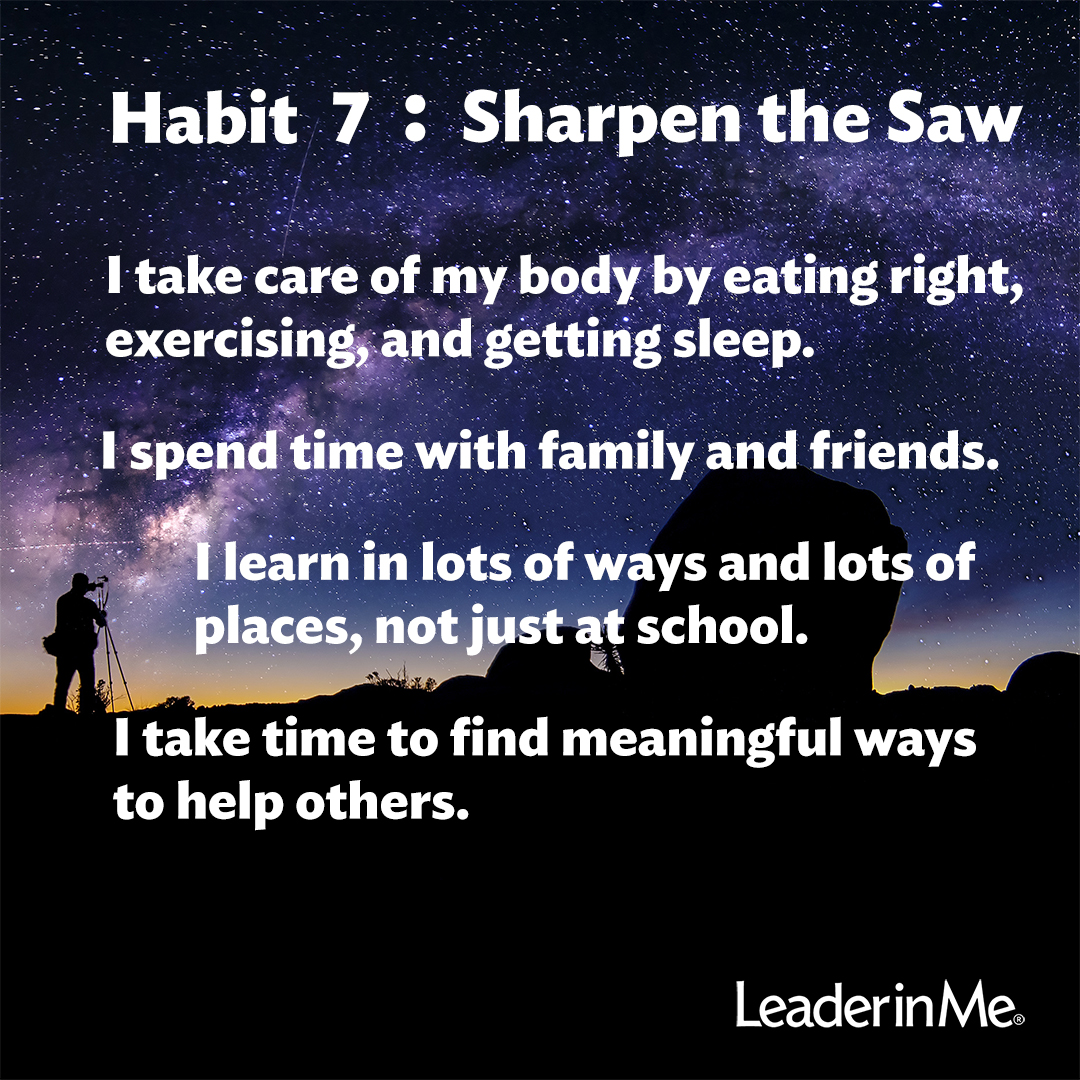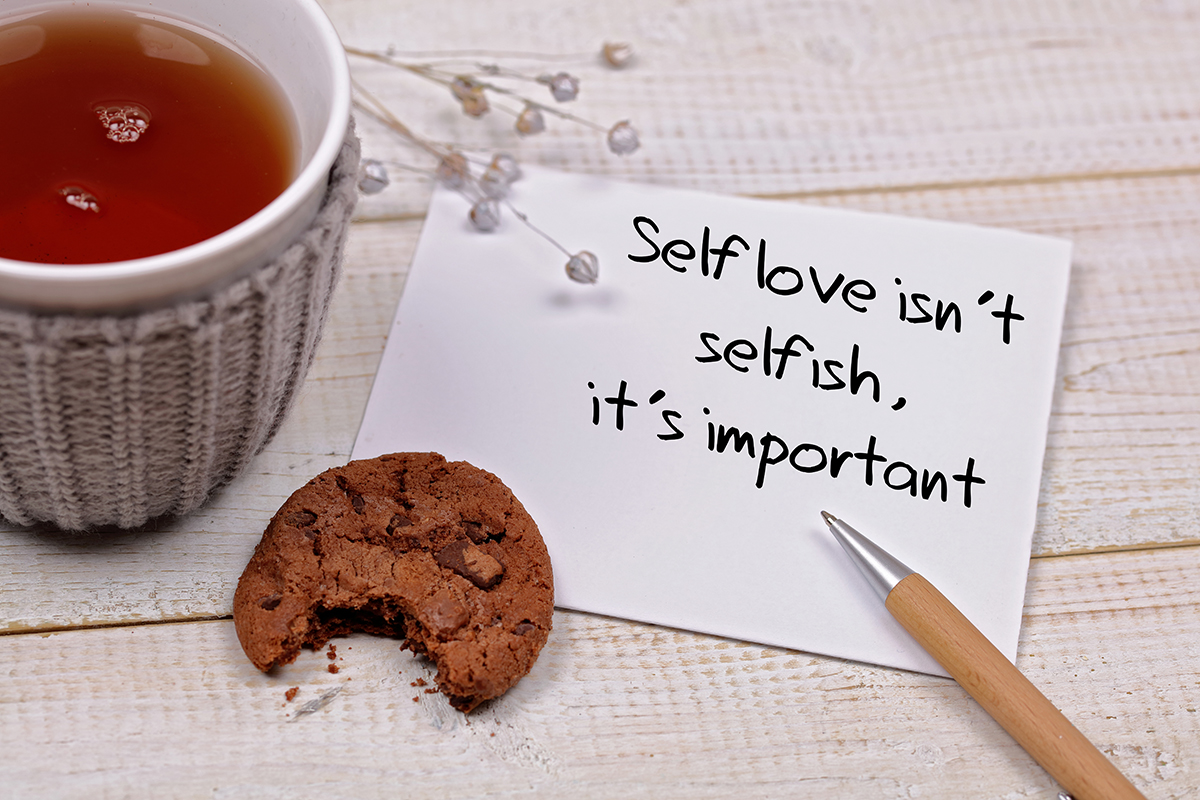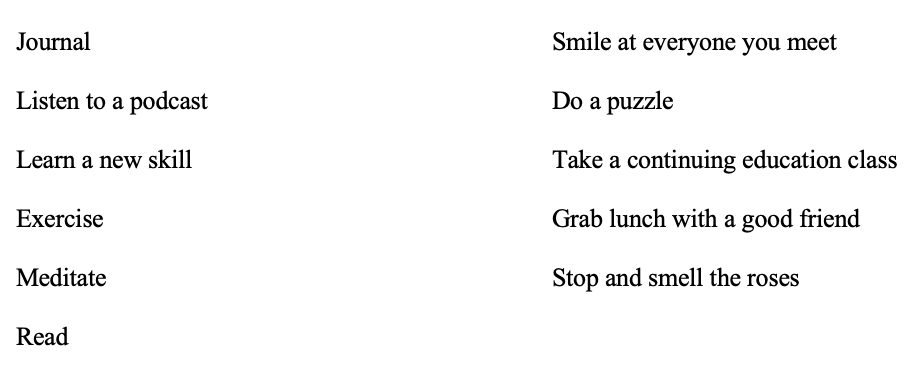Habit 7: Why It’s Important to Remember to Sharpen the Saw
Author: Tara West
September 25, 2019

Habit 7 is the habit of taking care of your body by eating right, exercising, and getting the right amount of sleep. It’s the habit of spending time with family and friends; to learn in lots of ways and lots of places, not just at school. The habit is about taking the time to find meaningful ways to help others.
In a nutshell, habit 7 is about taking care of yourself.
Habit 7: Sharpen the Saw®
Download Habit 7 Worksheet
Imagine you are going for a walk in the forest when you come upon a man sawing down a tree.
“What are you doing?” you ask. “I’m sawing down a tree,” he says.
“How long have you been at it?” You ask.
“Two or three hours so far,” he says, sweat dripping from his chin.
“Your saw looks dull,” you say. “Why don’t you take a break and sharpen it?”
“I can’t. I’m too busy sawing,” is his reply.
As an outsider, we could see that the process of cutting was dulling the blade. And the duller the blade, the greater the effort that is required to keep sawing. The solution, of course, was for the woodcutter to stop periodically to sharpen the saw. He was so engrossed in the situation he couldn’t see the need to take a break and do what was necessary to make his job easier.
Habit 7 teaches us to take the time to stop and “sharpen our saw.” “Sharpening the Saw” is synonymous with “self-care” or “self-renewal.”
Secure Your Own Oxygen Mask First

I have literally never sharpened a saw in my life but I have flown in an airplane hundreds of times. Growing up in an airline employee family, we would fly numerous times a year. My sister and I would see who could memorize the various announcements the flight attendants were required to make. We also wrote notes to future passengers on the motion sickness relief bags (that’s the official name for barf bags). There is one particular announcement that has a specific order of operations.
Sit back and imagine you are ready to take off to the beautiful Hawaiian Islands as the flight attendant announces:
“… If needed, oxygen masks will be released overhead. To start the flow of oxygen, reach up and pull the mask toward you, fully extending the plastic tubing. Place the mask over your nose and mouth and slip the elastic band over your head. To tighten the fit, pull the tab on each side of the mask. The plastic bag does not need to inflate when oxygen is flowing. Be sure to secure your own mask before assisting others.”
Why should we secure our own mask first? As a mom it goes against all my maternal instincts to think that I would help myself before helping my children. However, I have come to the conclusion that I am a better, more patient mom when I do take the time to “put on my own mask first.”
Even if it is something small.
For example, my husband recently brought me flowers to celebrate our 16th wedding anniversary. I literally found my self stopping to smell the roses in the kitchen. It’s totally cliché, but sometimes it’s small moments like this that rejuvenate me and help me be in a more positive state of mind.
This and other self-care practices are helping me to avoid becoming apathetic and burned out.
There are times when I require a bit more than the smell of the roses. I have recently started an exercise program. I have noticed many self-renewing benefits from doing so. I feel better in general. I don’t need as much caffeine to get through my day and I am sleeping much better. Bam! That’s a whole slew of benefits from one simple change. What is self-renewing to you will be different for me, it is a very personal activity.
Emotional Bank Account
Take a moment and consider the “emotional bank account” from Habit 4. It is the receiver that determines what’s a deposit or withdrawal for this account. Can we possibly fill our own emotional bank account? I would argue we can! After all, who knows us better than ourselves? When we take the time to care for ourselves and do things that personally enrich or invigorate us, we deposit into this account. When our account is full or being filled, we are more capable of filling others accounts. When we take the time to care for others especially our family members, the result is a happier and more successful family.
That is what Habit 7 is all about!
On one of those family flights I mentioned before, I was reading a book and a line stood out to me. “What would a personal day look like to your 10-year-old self?” I wish I could remember the book to give it credit. I have often thought of this sentence and pictured myself as a 10-year-old.
My day would involve riding my bike to get shave ice, then meeting up with friends at the park to spin on the merry-go-round. I would take off my shoes and play in the little brook that ran through the park. When it started to get dark, I would ride home to eat a home-cooked dinner made by my mom. Then, it would be off to play night games like “Ghost in the Graveyard” and “Capture the Flag.”
I believe this line struck me because, as kids, we are generally able to do the things that make us happy or fill our emotional bank accounts. If we didn’t get to, our imbalance (or “dull saw”) would be apparent in fit-throwing or talking back. As adults, we show our “dull saws” in other ways like being short-tempered, inpatient, or zoning out.
There are times I wish throwing a fit was socially acceptable for me as an adult! However, by learning to recognize when it’s time to “sharpen my saw,” I am able to make it happen.
If you are unsure of where to start “sharpening your saw,” here are some ideas to consider:

Habit 7: What does “sharpen the saw” look like in a family setting?
As a family, you can “sharpen the saw” together by creating and observing family traditions. When we work to build family traditions together, we show we are valuing the basic needs of individuals and our families. Renewing our family is where family bonding, identity, fulfillment, and happiness is found. Many of these renewal times come when we are giving time to the “Big Rocks” we learned in Habit 3; regular one on one-time, regular meals together, regular family times and family rituals and traditions. It may be helpful to ask your family members what some of their favorite family traditions are. Is there anything they would like to make a tradition? Is there a tradition they would like to discontinue?
In my family, we have started playing card games on Sunday afternoon. We usually pop popcorn and sit at the table together. We use this time to talk about our week and what we have going on. We also laugh a lot! This has become a fun tradition that we all look forward to.
While striving to have balance in our families we can look at the following four areas to assess where we are: Physical (our bodies), Mental (our mind/thoughts), Emotional (our feelings), and Spiritual. As a family, choose one or two areas to focus on at a time. Don’t overwhelm yourselves! Remember, the object is to strive for balance and that will look and feel different to each family.
More Leadership at Home Activities
To learn more about leadership at home, check out:
“Creating a Family Mission Statement”
Habit 3: A Family Exercise in Putting First Things First
Family Engagement in Schools: Leadership Skills Start at Home
